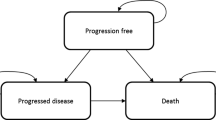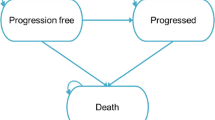Abstract
The UK National Institute for Health and Clinical Excellence (NICE) invited the manufacturer of erlotinib (Roche) to submit evidence for the clinical and cost effectiveness of erlotinib as monotherapy for the maintenance treatment of patients with non-small cell lung cancer (NSCLC) and stable disease following previous treatment with four cycles of platinumcontaining therapy. The Liverpool Reviews and Implementation Group(LRiG) at the University of Liverpool was commissioned to act as the Evidence Review Group (ERG) for this appraisal.
The ERG reviewed the clinical- and cost-effectiveness evidence in two stages and in accordance with the decision problem defined by NICE. The analysis of the submitted models assessed the appropriateness of the approach taken by the manufacturer in modelling the decision problem. Analysis also included reliability of model implementation and the extent of conformity to published standards and prevailing norms of practice within the health economics modelling community. Particular attention was paid to issues likely to have substantial impact on the base-case cost-effectiveness results.
Clinical evidence was derived from a multi-centre, double-blind, randomized, phase III study designed to address the overall population of NSCLC patients. Outcomes included progression-free survival (PFS) and overall survival (OS). The recruited population was mainly from outside of Western Europe and no patients in the pivotal trial had received pemetrexed as a firstline therapy, which is now accepted clinical practice in the UK. The evidence considered in this article includes only the population for whom marketing authorizations has been received–that is, patients with stable disease following first-line therapy.
The trial reported a small but statistically significant increase in both PFS and OS in patients with stable disease receiving erlotinib compared with placebo. However, no significant difference was identified in OS when patients with non-squamous disease and stable disease were considered as a subgroup.
The economic evidence was focussed on the ERG’s assessment of three economic models that related to patients with stable disease and compared erlotinib with placebo in the squamous and non-squamous populations and erlotinib with pemetrexed in the non-squamous population. The incremental cost-effectiveness ratios (ICERs) reported by the manufacturer were £39 936 per QALY gained (stable disease, all); £35 491 per QALY gained (stable disease, squamous); and £40 020 per QALY gained (stable disease, nonsquamous). In comparison with pemetrexed, in the cases where erlotinib was considered to be superior or equivalent, erlotinib dominated. In the cases where erlotinib was considered to be slightly inferior, then the ICERs ranged between £91 789 and £511 351 per QALY gained; these ICERs appear in the south-west corner of a cost-effectiveness plane, i.e. erlotinib is cheaper but less effective than pemetrexed.
The ERG recalculated the base-case cost-effectiveness results in the manufacturer’s submission, considering nine key areas where corrections and/or adjustments were required, related to time horizon, discounting logic, costs of erlotinib and pemetrexed, cost of second-line chemotherapy, unit costs, utility values, PFS and OS. This resulted in ERG-revised ICERs for the stable disease squamous population of £44 812 per QALY gained, in the stable disease non-squamous population of £68 120 per QALY gained, and, when erlotinib was compared with pemetrexed, the result was £84 029 per QALY gained. All values were above NICE’s perceived willingness-to-pay threshold. After the second Appraisal Committee meeting, the Committee did not recommend the use of erlotinib in this patient population.




Similar content being viewed by others
References
National Institute for Health and Clinical Excellence. Guide to the single technology (STA) process 2006 [online]. Available from URL: http://www.nice.org.uk/nicemedia/pdf/STA_Process_Guide.pdf [Accessed 2010 Dec 15]
Sculpher M. Single technology appraisal at theUKNational Institute for Health and Clinical Excellence: a source of evidence and analysis for decision making internationally. Pharmacoeconomics 2010; 28 (5): 347–9
Rodgers M, Griffin S, Paulden M, et al. Alitretinoin for severe chronic hand eczema: a NICE single technology appraisal. Pharmacoeconomics 2010; 28 (5): 351–62
Bagust A, Greenhalgh J, Boland A, et al. Cetuximab for recurrent and/or metastatic squamous cell carcinoma of the head and neck: a NICE single technology appraisal. Pharmacoeconomics 2010; 28 (6): 439–48
Stevenson M, Pandor A. Febuxostat for the management of hyperuricaemia in patients with gout: a NICE single technology appraisal. Pharmacoeconomics 2011; 29 (2): 133–40
Scotland G, Waugh N, Royle P, et al. Denosumab for the prevention of osteoporotic fractures in post-menopausal women: a NICE single technology appraisal. Pharmacoeconomics. Epub 2011 Aug 20
McKenna C, Maund E, Sarowar M, et al. Dronedarone for the treatment of atrial fibrillation: a NICE single technology appraisal. Pharmacoeconomics. In press
Holmes M, Carroll C, Papaioannou D. Dabigatran etexilate for the prevention of venous thromboembolism in patients undergoing elective hip and knee surgery: a NICE single technology appraisal. Pharmacoeconomics. In press
Boyers D, Jia X, Jenkinson D, et al. Eltrombopag for the treatment of chronic idiopathic (immune) thrombocytopenic purpura (ITP): a NICE single technology appraisal. Pharmacoeconomics. In press
Yang H, Craig D, Epstein D, et al. Golimumab for the treatment of psoriatic arthritis: a NICE single technology appraisal. Pharmacoeconomics. In press
National Institute for Health and Clinical Excellence. Lung cancer (non-small-cell, advanced or metastatic maintenance treatment)-erlotinib (monotherapy): appraisal consultation document. London: NICE, 2010 [online]. Available from URL: http://www.nice.org.uk/guidance/index.jsp?action=article&o=49243 [Accessed 2010 Dec 15]
Cancer Research UK. CancerStats. Lung cancer: UK incidence statistics. 2006 Jan [online]. Available from URL: http://info.cancerresearchuk.org/cancerstats/types/lung/incidence/ [Accessed 2011 Jan 15]
NHS Information Centre. National Lung Cancer Audit. 2007 [online]. Available from URL: http://www.ic.nhs.uk/webfiles/Services/NCASP/audits%20and%20reports/7089_Lung_Cancer_V5.pdf [Accessed 2011 Jan 15]
Roche Ltd. Erlotinib for the 1st line maintenance treatment of non-small cell lung cancer: submission to NICE Single Technology Appraisal Process 2010 [online]. Available from URL: http://www.nice.org.uk/guidance/index.jsp?action=download&o=49268 [Accessed 2011 Aug 15]
NHS Information Centre. National Lung Cancer 2008 Audit. 2009 [online]. Available from URL: http://www.ic.nhs.uk/webfiles/Services/NCASP/audits%20and%20reports/NHS%20IC%20Lung%20Cancer%20AUDIT%202009%20FINAL.pdf [Accessed 2010 Jan 15]
National Institute for Health and Clinical Excellence. Pemetrexed for the first-line treatment of non-small-cell lung cancer. London: NICE, 2008 [online]. Available from URL: http://www.nice.org.uk/nicemedia/pdf/TA181Guidance.pdf [Accessed 2010 Jan 15]
National Institute for Health and Clinical Excellence. Lung cancer (non-small-cell, first line)-gefitinib: appraisal consultation document. London: NICE, 2010 [online]. Available from URL: http://www.nice.org.uk/nicemedia/pdf/TA181Guidance.pdf [Accessed 2010 Dec 15]
National Institute for Health and Clinical Excellence. Lung cancer (non-small cell)-erlotinib. London: NICE, 2006 [online]. Available from URL: http://guidance.nice.org.uk/TA162 [Accessed 2009 Jul 15]
National Institute for Health and Clinical Excellence. Lung cancer (non-small-cell)-pemetrexed (maintenance): final appraisal document. London: NICE, 2009 [online]. Available from URL: http://www.nice.org.uk/guidance/index.jsp?action=download&o=48303 [Accessed 2010 Dec 15]
Data on file, Roche Ltd. Erlotinib: clinical research report. Report no. 10314602009
Cappuzzo F, Ciuleanu T, Stelmakh L, et al., on behalf of the SATURN investigators. SATURN: a double-blind, randomized, phase III study of maintenance erlotinib versus placebo following nonprogression with first-line platinumbased chemotherapy in patients with advanced NSCLC. Lancet Oncol 2010; 11 (6): 521–9
Roche Ltd. Tarceva® (erlotinib) tablets. NDA 21-743/S-016. Supplemental NDA: first-line maintenance therapy in patients with locally advanced or metastatic NSCLC. Briefing document for 16 December 2009 ODAC meeting. Submission date: 12 November 2009. New York: OSI Pharmaceuticals, 2009 [online]. Available from URL: http://www.fda.gov/downloads/AdvisoryCommittees/CommitteesMeetingMaterials/Drugs/OncologicDrugsAdvisoryCommittee/UCM193921.pdf [Accessed 2010 Dec 15]
European Medicines Agency. Summary of opinion: Tarceva (erlotinib). London: European Medicines Agency, 2010
Ciuleanu T, Brodowicz T, Kim J, et al. Maintenance pemetrexed plus best supportive care versus placebo plus best supportive care for non-small-cell lung cancer: a randomised, double-blind, phase 3 study. Lancet 2009; 374: 1432–40
Eli Lilly & Co. Single technology appraisal: pemetrexed in the maintenance treatment of non-small cell lung cancer. Manufacturer submission. London: NICE, 2009 [online]. Available from URL: http://www.nice.org.uk/guidance/index.jsp?action=download&o=46610 [Accessed 2011 Jan 15]
Bagust A, Boland A, Dundar Y, et al. Pemetrexed for the treatment of relapsed non-small cell lung cancer. Liverpool: Liverpool Reviews and Implementation Group, 2010 [online]. Available from URL: http://www.hta.ac.uk/erg/reports/1641.pdf [Accessed 2011 Jan 15]
Acknowledgements
This project was funded by the National Institute for Health Research (NIHR) Health Technology Assessment Programme (project number 08/40/01) and will be published as part of a compendium of ERG articles in Health Technology Assessment. See the HTA programme website for further project information (http://www.hta.ac.uk). This summary of the ERG report was compiled after the AC’s consideration of the evidence.
The views and opinions expressed are those of the authors and do not necessarily reflect those of the National Institute for Health and Clinical Excellence or the Department of Health.
The authors have no competing interests that are directly relevant to the content of this review.
Author information
Authors and Affiliations
Corresponding author
Rights and permissions
About this article
Cite this article
Dickson, R., Bagust, A., Boland, A. et al. Erlotinib Monotherapy for the Maintenance Treatment of Non-Small Cell Lung Cancer after Previous Platinum-Containing Chemotherapy. Pharmacoeconomics 29, 1051–1062 (2011). https://doi.org/10.2165/11591600-000000000-00000
Published:
Issue Date:
DOI: https://doi.org/10.2165/11591600-000000000-00000




